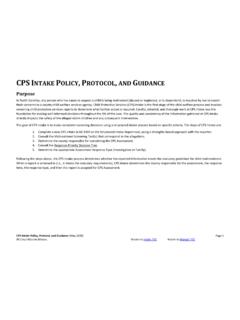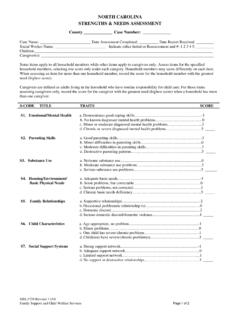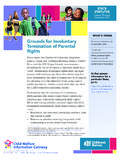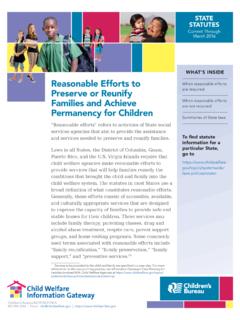Transcription of P SERVICES POLICY PROTOCOL AND GUIDANCE
1 PERMANENCY PLANNING SERVICES POLICY , PROTOCOL , AND GUIDANCE Purpose Permanency Planning SERVICES POLICY , PROTOCOL , and GUIDANCE (April 2022) Page 1 NC CHILD WELFARE MANUAL Return to Permanency Planning TOC Return to Manual TOC Permanency Planning SERVICES are provided to children who must be separated from their own parents or caretakers when they are unable or unwilling to provide adequate protection and care. As a result, the child enters the custody of a North Carolina county child welfare SERVICES agency. When this happens, the county child welfare SERVICES agency has legal custody and/or placement responsibility, whether the child has been removed from their home, and regardless of the type of placement.
2 County child welfare custody must not be considered until reasonable efforts have been made to preserve a child s safety, health, and well-being in their own home. County child welfare agencies are required to provide SERVICES to preserve or reunify families until parental rights have been terminated by the juvenile court. When county child welfare custody is necessary, it is the responsibility of the county child welfare SERVICES agency to ensure the child remains in its custody for the shortest time possible. Permanency Planning SERVICES require a thorough assessment of the child and family s needs and careful planning prior to and throughout a child s experience in county child welfare custody.
3 Permanency Planning SERVICES must be provided to any child in the custody or placement responsibility of a county child welfare SERVICES agency. Permanency Planning SERVICES include but are not limited to: o Careful planning and decision making with the family about placement, when necessary, and preparing the child, the child s family, and the foster family for separation and placement, including developing a family time and contact (visitation) agreement; o Assessing children s needs to ensure appropriate placement and SERVICES ; o Arranging and monitoring a placement appropriate to the child s needs; o Involving the kinship network to provide planning, placement, and other support for the child and family.
4 O Assessing family strengths and needs to determine the appropriate plan for service; o Developing and arranging community-based SERVICES to support the child and family; o Collaborating with other community service providers working with the family to ensure continuity of SERVICES and to prevent duplication of SERVICES ; o Referring the child and family to needed SERVICES , including clinical treatment; o Collaborating with educational agencies to ensure school stability for the child and that all factors relating to the child s best interest are considered in determining the child s educational setting; all appropriate educational SERVICES are provided to the child; and documentation of educational planning is in the case file; o Providing ongoing assessment to determine risk to the child and to guide the case planning process; o Working with the family to develop and implement the Permanency Planning Family SERVICES Agreement.
5 Permanency Planning SERVICES POLICY , PROTOCOL , and GUIDANCE (April 2022) Page 2 NC CHILD WELFARE MANUAL Return to Permanency Planning TOC Return to Manual TOC o Helping the family meet the Permanency Planning Family SERVICES Agreement objectives by providing information, instruction, GUIDANCE , and mentoring related to parenting skills, and by monitoring and updating the agreement with the family; o Providing case planning and management; o Concurrent permanency planning with the family to develop alternative options to provide a permanent home for a child should reunification fail; o Supervising the placement to ensure the child receives proper care during placement; o Preparing for and participating in court proceedings; o Preparing for and facilitating Child and Family Team /Permanency Planning Review meetings; o Providing transportation for children in county child welfare agency custody when needed and not otherwise available, including visits with parents, siblings, and relatives; o Providing LINKS SERVICES to assist older youth in learning life skills necessary to make a successful transition from foster care to living on their own.
6 O Ensuring placements across state lines comply with the Interstate Compact on the Placement of Children (ICPC); o Recruiting and assessing relatives and other kin as potential caregivers; o Involving foster parents in planning and decision making for children in county child welfare agency custody; o Preparing children for adoptive placements and maintaining life books; and o Maintaining the permanency planning case record and thorough documentation of case activities. Foster care can be defined as a situation in which, for a period, a child lives with and is cared for by people who are not the child s parents. There are different forms of foster care, including but not limited to: o Family foster homes, o Therapeutic foster homes, and o Residential care.
7 For child welfare, foster care refers to children in the legal custody of a county child welfare SERVICES agency; however, a child may also be placed in foster care by their parent without involvement of a county child welfare SERVICES agency. In order to keep children in foster care connected to their family, it is important to consider the child s culture. Child welfare defines culture as a set of learned values, beliefs, customs, traditions, and practices shared by a group of people and can be passed from one generation to another. This can include, but is not limited to: religion, ethnic customs, traditions of family and community. PERMANENCY PLANNING SERVICES Table of Contents Permanency Planning SERVICES POLICY , PROTOCOL , and GUIDANCE (April 2022) Page 3 NC CHILD WELFARE MANUAL Return to Permanency Planning TOC Return to Manual TOC Description Page POLICY & Legal Basis 6 Required Timeframes (for compliance with POLICY and PROTOCOL ) 9 PROTOCOL and GUIDANCE Case Staffing / Two-Level Decision Making / Role of Supervisor 12 Required Forms 14 Planning Forms Relative Notification Permanency Planning Review / Out of Home Family SERVICES Agreement Family Time and Contact (Visitation)
8 Plan Decision-Making Tools Child Health Summary Components Child Education Status Form and Best Interest Determination Form Monthly Permanency Planning Contact Record Eligibility/Payment/Reporting Forms Child Placement and Payment System Report SIS Client Entry Form Determination of Foster Care Assistance Benefits and/or Medical Assistance Only and Redetermination of Foster Care Assistance Benefits and/or Medical Assistance Only 14 14 17 20 23 25 28 29 31 31 31 32 Domestic Violence and Permanency Planning 33 Human Trafficking 34 Placement Decision Making: Maintaining One Single, Stable Placement 35 Choosing the Best Placement Resource Placement with Siblings Placement Options Kinship Care (Relative and Non-Relative Kin) Kinship Care Assessment.
9 Licensure and Approval Other Placement Resources 36 36 37 39 40 41 PERMANENCY PLANNING SERVICES Table of Contents Permanency Planning SERVICES POLICY , PROTOCOL , and GUIDANCE (April 2022) Page 4 NC CHILD WELFARE MANUAL Return to Permanency Planning TOC Return to Manual TOC Description Page Special Legal Considerations in Placement Decision Making Multiethnic Placement Act of 1994 and Amendment (MEPA-IEP) Indian Child Welfare Act of 1978 Mexican Heritage 44 44 44 44 Preparing Parents, Children, and Providers for Placement 45 Preparing Parents and Children Preparing Placement Providers reasonable and Prudent Parent Standard 45 45 45 Out-of-Home Placement SERVICES 47 Required Contacts Initial Contacts Ongoing Contacts Water Safety Hazards Ongoing Placement SERVICES Required SERVICES for Children Involvement with Juvenile Justice Authorization for Healthcare SERVICES Ongoing Needs Assessment Life Books Required SERVICES for Parents Required SERVICES for Placement Providers Ongoing Risk Assessment Educational Stability School Attendance Every Student Succeeds Act Parent/Child Visitation/Family Time Sibling Visitation Agency Plan for
10 Abducted and Runaway Children 47 47 49 53 55 55 56 59 60 61 63 65 67 69 69 69 75 81 83 PERMANENCY PLANNING SERVICES Table of Contents Permanency Planning SERVICES POLICY , PROTOCOL , and GUIDANCE (April 2022) Page 5 NC CHILD WELFARE MANUAL Return to Permanency Planning TOC Return to Manual TOC Description Page Shared Parenting 92 Permanency Planning 96 Permanency Options Reunification Guardianship Custody APPLA Adoption Reinstatement of Parental Rights Concurrent Planning Permanency Planning Hearing 98 101 102 107 108 109 113 115 118 Child and Family Team / Permanency Planning Review Meetings 120 Permanency Planning Review Team Meetings Child and Family Team Meetings 120 125 Termination of SERVICES 127 Preparing the Child Preparing the Family for Reunification Preparing the Foster Family Preparing the Adoptive Family or Other Permanent











